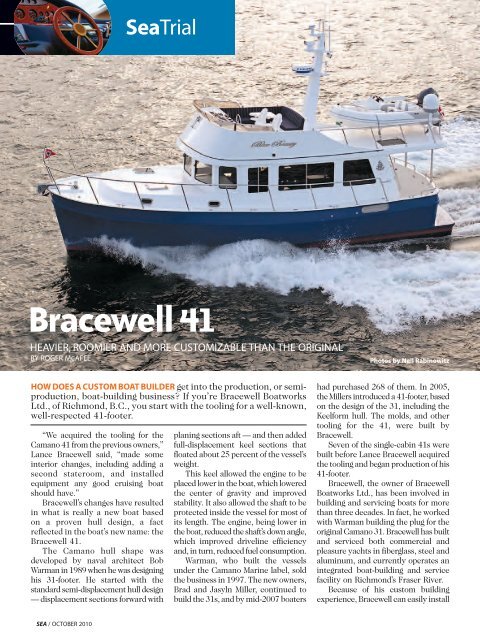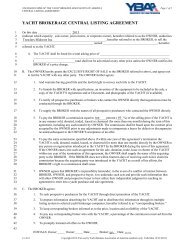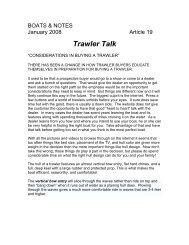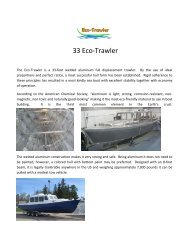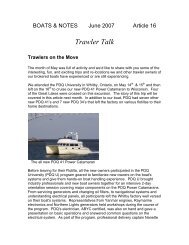Bracewell 41 - Trawlers Midwest
Bracewell 41 - Trawlers Midwest
Bracewell 41 - Trawlers Midwest
Create successful ePaper yourself
Turn your PDF publications into a flip-book with our unique Google optimized e-Paper software.
SeaTrial<br />
<strong>Bracewell</strong> <strong>41</strong><br />
HEAVIER, ROOMIER AND MORE CUSTOMIZABLE THAN THE ORIGINAL<br />
BY ROGER MCAFEE<br />
Photos by Neil Rabinowitz<br />
HOW DOES A CUSTOM BOAT BUILDER get into the production, or semiproduction,<br />
boat-building business? If you’re <strong>Bracewell</strong> Boatworks<br />
Ltd., of Richmond, B.C., you start with the tooling for a well-known,<br />
well-respected <strong>41</strong>-footer.<br />
“We acquired the tooling for the<br />
Camano <strong>41</strong> from the previous owners,”<br />
Lance <strong>Bracewell</strong> said, “made some<br />
interior changes, including adding a<br />
second stateroom, and installed<br />
equipment any good cruising boat<br />
should have.”<br />
<strong>Bracewell</strong>’s changes have resulted<br />
in what is really a new boat based<br />
on a proven hull design, a fact<br />
reflected in the boat’s new name: the<br />
<strong>Bracewell</strong> <strong>41</strong>.<br />
The Camano hull shape was<br />
developed by naval architect Bob<br />
Warman in 1989 when he was designing<br />
his 31-footer. He started with the<br />
standard semi-displacement hull design<br />
— displacement sections forward with<br />
planing sections aft — and then added<br />
full-displacement keel sections that<br />
floated about 25 percent of the vessel’s<br />
weight.<br />
This keel allowed the engine to be<br />
placed lower in the boat, which lowered<br />
the center of gravity and improved<br />
stability. It also allowed the shaft to be<br />
protected inside the vessel for most of<br />
its length. The engine, being lower in<br />
the boat, reduced the shaft’s down angle,<br />
which improved driveline efficiency<br />
and, in turn, reduced fuel consumption.<br />
Warman, who built the vessels<br />
under the Camano Marine label, sold<br />
the business in 1997. The new owners,<br />
Brad and Jasyln Miller, continued to<br />
build the 31s, and by mid-2007 boaters<br />
had purchased 268 of them. In 2005,<br />
the Millers introduced a <strong>41</strong>-footer, based<br />
on the design of the 31, including the<br />
Keelform hull. The molds, and other<br />
tooling for the <strong>41</strong>, were built by<br />
<strong>Bracewell</strong>.<br />
Seven of the single-cabin <strong>41</strong>s were<br />
built before Lance <strong>Bracewell</strong> acquired<br />
the tooling and began production of his<br />
<strong>41</strong>-footer.<br />
<strong>Bracewell</strong>, the owner of <strong>Bracewell</strong><br />
Boatworks Ltd., has been involved in<br />
building and servicing boats for more<br />
than three decades. In fact, he worked<br />
with Warman building the plug for the<br />
original Camano 31. <strong>Bracewell</strong> has built<br />
and serviced both commercial and<br />
pleasure yachts in fiberglass, steel and<br />
aluminum, and currently operates an<br />
integrated boat-building and service<br />
facility on Richmond’s Fraser River.<br />
Because of his custom building<br />
experience, <strong>Bracewell</strong> can easily install<br />
SEA / OCTOBER 2010
items any individual buyer might like.<br />
The owner of our test boat works in<br />
the marine service industry and wanted<br />
a complete hydraulic system on his new<br />
<strong>41</strong>. It was installed during the build.<br />
Having tested the first <strong>41</strong>-footer out<br />
of the mold in 2006, I looked forward<br />
to a chance to test <strong>Bracewell</strong>’s new <strong>41</strong>,<br />
and that chance came in May at a<br />
trawler gathering in Anacortes, Wash.<br />
NEW LOOK & FEEL<br />
Even at first glance there is no doubt<br />
that <strong>Bracewell</strong> has stayed true to the<br />
original Camano sedan design. The<br />
vessel still has that slightly softened,<br />
husky, broad-shouldered workboat<br />
look about it — upright windows all<br />
around, slightly swept sheer, curved<br />
transom, a large, useful swim grid and<br />
a wash-and-wear exterior.<br />
There are, however, subtle but<br />
significant changes. The most obvious<br />
is the extension of the deckhouse roof<br />
aft so rain runoff dumps onto the swim<br />
step rather than onto the aft deck. On<br />
the first day of the trawler gathering,<br />
a rain- and hailstorm hit, and everyone<br />
on the back decks of the other<br />
trawlers — about 40 of them — had<br />
to rush inside to keep dry. Those of<br />
us on the back deck of the <strong>Bracewell</strong><br />
carried on with conversation and<br />
coffee. Experienced tropical cruisers<br />
will also appreciate the covered aft deck<br />
for the shade it provides from the<br />
relentless sun.<br />
A less obvious change is the mast.<br />
On the original <strong>41</strong>, the mast was really<br />
nothing more than a radar pedestal,<br />
and antennas were fixed to the<br />
command bridge at various locations.<br />
<strong>Bracewell</strong>’s mast is much more<br />
substantial and carries most of the<br />
antennas as well as radar.<br />
The additional weight of the<br />
deckhouse extension and mast has<br />
solved what some considered a design<br />
deficiency in the original <strong>41</strong> — a quick<br />
roll recovery that can be uncomfortable.<br />
In the test of the original <strong>41</strong>, I noticed<br />
the quick roll return, but I didn’t have<br />
a problem with it. However, the added<br />
weight up top on <strong>Bracewell</strong>’s <strong>41</strong> gives<br />
the vessel an easier, more comfortable<br />
motion, particularly in a seaway.<br />
A transom gate off the swim step<br />
allows boarding access. That step, in<br />
An Inside Look<br />
TESTER’S OPINION<br />
“Lance <strong>Bracewell</strong> brings a custom-builder’s touch to a<br />
production boat.”<br />
keeping with most new swim-step<br />
designs, is about the same height off<br />
the water as most floating docks,<br />
which makes for an easy step from the<br />
dock to the boat. This is a small but<br />
important feature to boaters with small<br />
children or aging parents.<br />
The cockpit is large, with high<br />
coamings and beefy, stainless handrails,<br />
an ideal place for fishing or just<br />
lounging. It has a complete set of engine<br />
controls. A ladder on the cockpit port<br />
side leads up to the command bridge<br />
and dinghy deck. The visibility from<br />
the command helm is excellent, and<br />
Windows in every wall flood the<br />
deckhouse with natural light, and a<br />
second stateroom is a welcome<br />
addition.<br />
there’s plenty of room up top for sun<br />
worshipers.<br />
All deck surfaces are a sharp,<br />
molded-in, nonskid surface that<br />
provides good footing even in the rain.<br />
It also provided reasonably good footing<br />
in the hailstorm we experienced.<br />
A watertight door opens into a<br />
deckhouse flooded with natural light<br />
because of windows in every deckhouse<br />
wall and a glass window in the aft door.<br />
The deckhouse itself is spacious and<br />
open, with a double-seat helm forward<br />
to starboard, from which visibility is<br />
excellent all around. The galley is<br />
neilrabinowitz.com<br />
SEAMAGAZINE.COM
<strong>Bracewell</strong><br />
<strong>41</strong><br />
SPECIFICATIONS<br />
LOA<br />
<strong>41</strong> ft.<br />
Beam<br />
14 ft.<br />
Draft<br />
3 ft., 9 in.<br />
Weight<br />
28,000 lbs. (half load)<br />
Fuel<br />
400 gals.<br />
Fresh water<br />
200 gals.<br />
Cruising speed<br />
8 knots<br />
Max speed<br />
16 knots<br />
Engine Volvo Penta D6-435<br />
STANDARD EQUIPMENT<br />
Stainless steel bowrails, 800-lb. davit, 10-foot<br />
inflatable, 10 hp bow thruster, integral selfdraining<br />
anchor locker, nonskid surface on all<br />
exterior weather decks, two pedestal bridge<br />
seats, full-sized wet locker, convertible dinette<br />
in salon, washer/dryer, complete entertainment<br />
package, boarding platform, international<br />
running lights, two opening hatches over<br />
forward cabins, transom storage<br />
compartments (2), swim ladder, lazarette<br />
locker, full-length stainless steel handholds on<br />
sidedecks, port and starboard stainless steel<br />
deck fills (water and fuel) and more.<br />
OPTIONAL EQUIPMENT<br />
See dealer for a full list of optional features.<br />
BUILDER<br />
BRACEWELL BOATWORKS, Richmond, B.C.;<br />
(604) 821-1890; bracewellboatworks.com<br />
WEST COAST DEALERS<br />
WaterLine Boats, Seattle; (206) 282-0110;<br />
waterlineboats.com<br />
North 49 Yacht Sales, Richmond, B.C.;<br />
(604) 899-4430, north49yachtsales.com<br />
forward to port, and an L-shaped settee,<br />
with storage underneath, and a folding<br />
dining table, is located in the aft<br />
starboard corner of the deckhouse. The<br />
table drops down to form a double bunk.<br />
Across from the settee is an<br />
entertainment center, complete with<br />
a small desk. A swivel tub chair sits in<br />
the space between the entertainment<br />
center and the galley.<br />
Below, forward of the helm station,<br />
is the space that is most different from<br />
the original <strong>41</strong>s. Those boats had a<br />
single stateroom, whereas <strong>Bracewell</strong>’s<br />
new offering has two staterooms — a<br />
forecastle master and a port-side guest<br />
cabin. Also down and forward is the<br />
head, complete with a freshwater<br />
toilet, a vanity, a separate glass shower<br />
stall and plenty of storage. The master<br />
is well finished with plenty of natural<br />
light from twin overhead hatches and<br />
twin ports, all of which can be opened<br />
to allow for cross ventilation. There’s<br />
plenty of stowage and a comfortable<br />
padded bench on each side of the island<br />
queen bed.<br />
The guest stateroom is a comfortable<br />
double and is complete with an opening<br />
porthole, overhead and reading lights,<br />
and an LCD flat-screen TV. The guest<br />
stateroom on our test boat also houses<br />
a combination washer/dryer. That<br />
space could also be finished as an<br />
onboard office.<br />
ON THE MOVE<br />
We fired up the Volvo D6-435 and<br />
eased away from the dock. This sixcylinder,<br />
336-cubic-inch (5.5L), electronically<br />
controlled, common-rail<br />
engine started quickly and easily with<br />
no fuss or smoke. It ran quietly,<br />
reading 62 decibels at its 600 rpm idle<br />
speed. This double overhead cam, fourvalve-per-cylinder<br />
power plant, new in<br />
the Volvo line in 2009, is turbocharged<br />
and aftercooled. It weighs in at 1,5<strong>41</strong><br />
pounds and has a cast-iron block and<br />
head. It is compact and light for the<br />
power it produces.<br />
Despite a fresh breeze, and with<br />
barely a touch of the thrusters, we<br />
moved away from the dock. Even in<br />
the wind the vessel tracked straight and<br />
true, despite the slow speed — 3.7 knots<br />
— we were going.<br />
When we cleared the no-wake<br />
zone, we set the engine at 900 rpm and<br />
were making 4.5 knots and burning 0.6<br />
gph. At 1200 rpm, we burned 0.8 gph<br />
and made 5.9 knots; our noise meter<br />
read 65 decibels.<br />
We made 7.5 knots at 1500 rpm and<br />
burned 1.37 gallons per hour. The noise<br />
level was 70 decibels, about the same<br />
as a normal conversation. At 2000 rpm,<br />
we made 9.3 knots while burning 4.22<br />
gph; 2500 rpm gave us 10.8 knots with<br />
a fuel burn of 7.92 gph. Noise level was<br />
75 decibels. We burned 12.94 gph and<br />
made 12.9 knots at 3000 rpm. At wideopen<br />
throttle — 3600 rpm — we made<br />
17 knots and burned 22.1 gph.<br />
All speeds were measured by GPS,<br />
and fuel-consumption figures were<br />
generated by the engine computer.<br />
The fuel consumption of this vessel<br />
at 7.5 knots is 5.47 nautical miles per<br />
gallon — remarkable for a vessel of<br />
this size. Its range, allowing a 10<br />
percent reserve, is 1,969 nautical<br />
miles, or 2,264 statute miles. According<br />
to the builder, this speed range is where<br />
the Keelform hull really shines. “As<br />
speeds increase,” <strong>Bracewell</strong> said, “the<br />
vessel continues to get good fuel<br />
economy, but toward the top end it<br />
becomes more ordinary.”<br />
During our test, the vessel handled<br />
easily, responded smartly to the helm<br />
and tracked well. As we moved along<br />
at various speeds, I went below looking<br />
for doors or drawers that rattled or slid<br />
open and didn’t find any. Hatches and<br />
ports stayed dogged down, and there<br />
was no discernable paneling vibration<br />
or drumming. The transom door stayed<br />
firmly in place, and I couldn’t find any<br />
loose or vibrating rails or deck fittings.<br />
As we went through various<br />
maneuvers, the vessel always felt solid<br />
underfoot and had an easier motion<br />
than the original Camano <strong>41</strong>, due to<br />
the extra weight up top, as already<br />
noted, and the fact that our test vessel<br />
weighs about a ton more than the<br />
original <strong>41</strong>. Part of that extra weight<br />
comes from additional equipment<br />
specified by the owner.<br />
Lance <strong>Bracewell</strong> brings a custombuilder’s<br />
touch to a production boat.<br />
He has recognized the excellent design<br />
qualities of the Camano Keelform hull<br />
and provided his experience in fitting<br />
the vessel out, so a buyer can fire up<br />
the engine, take aboard food, fuel and<br />
water, and go cruising.<br />
SEA / OCTOBER 2010


